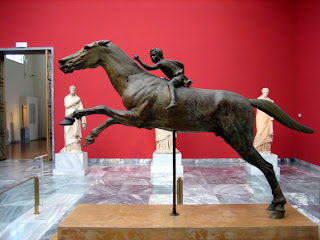BAROQUE ART – HIGH BAROQUE
Baroque art began around 1600 in Rome and Italy, and spread to most of Europe. This movement serves as a reaction against the intricate and formulaic Mannerist style which dominated the Late Renaissance. Baroque Art is less complex, more realistic and more emotionally affecting than Mannerism. This movement was encouraged by the Catholic Church in response to the Protestant Reformation, and that the arts should communicate religious themes with direct and emotional involvement. On the other hand, the aristocracy viewed the dramatic style of Baroque art and architecture as a means of impressing visitors by projecting triumph, power, and control.
Ecstasy of Saint Teresa
By Gian Lorenzo Bernini
1647 - 1652
The Ecstasy of Saint Teresa is the central sculptural group in white marble set in an elevated altar in the Cornaro Chapel, Santa Maria della Vittoria, Rome. It was designed and completed by Gian Lorenzo Bernini, the leading sculptor of his day, who also designed the setting of the Chapel in marble, stucco and paint. It is generally considered to be one of the sculptural masterpieces of the High Roman Baroque. The Ecstasy of St. Teresa represents an episode from the life of the saint as recorded in her spiritual autobiography. Teresa describes an angel carrying a fire-tipped spear with which he pierces her heart repeatedly, an act that sends her into a state of spiritual rapture.
Bernini’s sculptural group shows a cupid-like angel holding an arrow. His delicate touch and lithe figure give him an air of grace. With her head thrown back and eyes closed, Teresa herself collapses, overcome with the feeling of God’s love. Her physical body seems to have dematerialized beneath the heavy drapery of her robe. Twisting folds of fabric energize the scene and bronze rays, emanating from an unseen source, seem to rain down divine light. The combined effect is one of intense drama, the ethereality of which denies the true nature of the work of art. Despite being made of heavy marble, saint and angel – set upon a cloud – appear to float weightlessly.
When we walk toward the chapel, we see what look like theater boxes on the walls on either side. In these boxes, seated figures appear to be talking and gesturing to each other. Perhaps they are kneeling in prayer as they watch and discuss the scene of the Ecstasy of Saint Teresa displayed before them.
Members of the Cornaro family, Ecstasy of Saint Teresa
By Gian Lorenzo Bernini
1645 - 1652
Who are these figures in the theater boxes? One is Federico Cornaro, Cardinal of Venice and the patron who paid for the Cornaro Chapel. The others are posthumous portraits of members of the Cornaro family (many of them were also Cardinals). Behind them Bernini created a fabulous illusion of architecture – a coffered barrel vault, doorway and columns.
If we follow the metaphor of a theater, it feels as though we've got the best seats in the house! And importantly, what's happened is that we have immediately become a part of the work of art. It surrounds us, and we are literally inside of it. This is, as we have seen, a typical feature of Baroque art – breaking down the barrier between the work and the viewer – to involve us.





Comments
Post a Comment